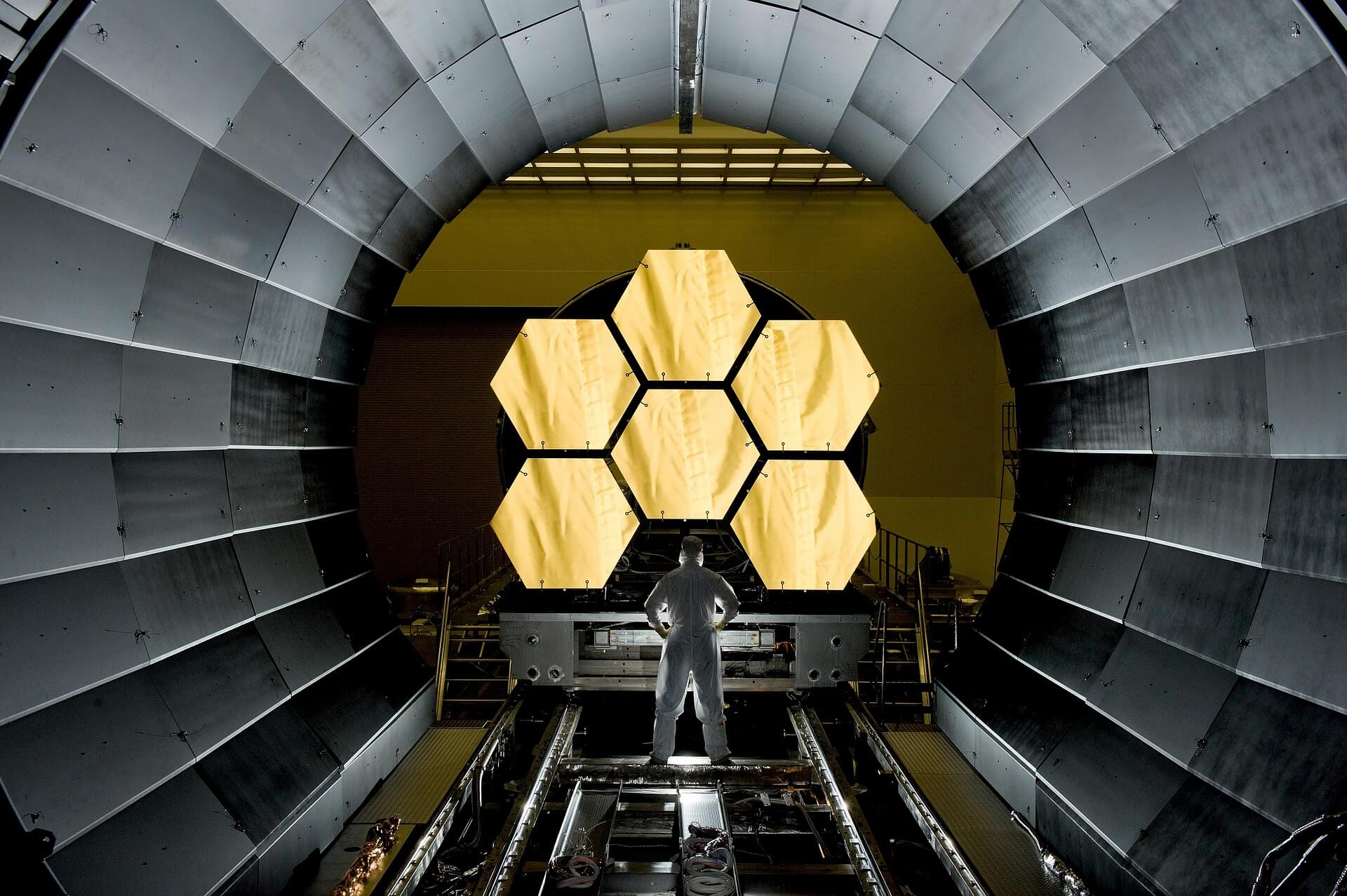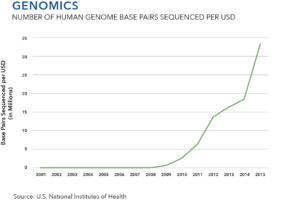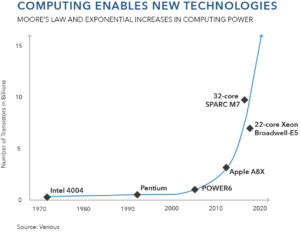Transformative Technologies
Technology is transformative. Many of the most prominent and fastest-occurring catalysts are a result of technological advances. Innovations such as the printing press, steam and internal combustion engines, electricity, and personal computers have indisputably altered the course of history. Technology has also enabled or set the conditions for other catalysts. For example, urbanization is rooted in changes to agricultural technology. While the World Wars were political catalysts, technology enabled their world-spanning effects. Except for nonhuman-originated environmental issues, there has arguably been and will continue to be a technological component in every catalyst.
Ongoing advances in technology will obviously continue to shape economies, markets, and global economic systems. However, technology as a category is far too broad to be useful for business and public sector planners. Within the broader context of technology, a number of developments have the potential to catalyze more dramatic step-function changes to the global system. Below are some of the specific fields and technologies with the highest potential for transformative impact that we are closely following.
Genomics, Biotechnology, and Bioengineering
Advances in genomics, biotechnology, bioengineering, and related overlapping and emerging fields could reframe both lifelong health and the human life span and thus drive a multitude of second- and third-order effects. Anything that allows people to live longer or remain healthy and active to a more advanced age has the potential to change what they do, where they live, what they buy, and how they vote. Health and longevity, along with food, energy, and water, constitute the base layers of human need, and any changes to those underlying structures have far-reaching effects.
Genomics is the study and manipulation of the human genome. Most of the current research is focused on curing disease and increasing longevity. This is important work that is incrementally changing human health. However, the potential for transformation occurs when the majority of research and technology development efforts focus on genomic enhancement and augmentation, which can truly impact how people live.
Biotechnology deals with living organisms and biological systems to develop new technologies and products for use in medicine as well as agriculture and industry. These technologies range from manipulating microorganisms to produce hormones and other drugs to genetically modifying crops and biofuels.
Bioengineering involves medical uses of engineering principles, such as embedded sensors and devices that circulate through the bloodstream, exoskeletons that allow amputees fuller mobility or enhance the abilities of soldiers, and the construction of artificial tissues and organs. The intersection of bioengineering and neuroscience is specifically interesting as relates to cognitive enhancement and mind-machine interfaces.
Machine Learning and Artificial Intelligence
Machine learning and artificial intelligence (AI) also have the potential for system-wide catalytic effects, although more widespread transformation may take some time to become a reality. Limited AI that enhances current tools will facilitate increased productivity and standards of living. General AI, which would equal or surpass human intelligence, has the potential to change the world, optimizing or automating entire industries.
There are second- and third-order effects of industrial automation. The process of optimization generally involves displacing large groups of workers, which results in increasing social and political pressure. The optimization of weapon systems and defense technologies has the capacity to change the relative strength of nations, with potentially disastrous effects. There is also an inherent existential danger in general AI, as described in detail in Nick Bostrom’s book, Superintelligence.
Various Robotics and AI Worldwide Market Size Estimates by Segment, 2018-2030
| Segment and Forecast Year | Market Size (in billions USD) |
| Robo-advisor (2020) | 255 |
| Autonomous car (2030) | 87 |
| Artificial intelligence analytics (2020) | 70 |
| Logistics, packaging, and materials (2020) | 31 |
| Industrial robots (2025) | 24 |
| Surgical (2022) | 18 |
| Personal and care-bots (2020) | 17.4 |
| Agricultural robots (2020) | 16.3 |
| Drones (2025) | 14 |
| Domestic robots (2018) | 12.2 |
| Entertainment and leisure (2018) | 7.6 |
| Military (2018) | 7.5 |
| Exoskeletons (2021) | 2.1 |
| Rehabilitation (2021) | 1.1 |
Source: Bank of America, Merrill Lynch
Quantum Computing and Cybersecurity
Quantum computing will enhance processing power by orders of magnitude, which will be an enabling factor for a variety of technologies, including AI and machine learning, as discussed above. Simply put, quantum computing allows for parallel processing at a massive scale by featuring qubits that have a multitude of possible states based on quantum superposition, as opposed to bits used in traditional computing, which are binary with two possible states. Quantum computers are in their early stages but will likely follow the developmental path of today’s computers, first being featured in state-sponsored supercomputers before reaching commercial size, cost, and scale.
Quantum computing will enhance computation-intensive technologies. It will also provide the computing power to essentially nullify the encryption practices that provide the underpinning of all software products and platforms. It is critically important to understand that current best-class encryption practices are totally exposed to defeat by the computing power inherent in quantum computers. The most likely outcome is that new encryption technologies will be developed that can counter this threat, but the dynamic is most certainly changing, and everyone using digital technology will be compelled to react.
Space Technology
A variety of potential discoveries associated with space technology could have a transformative impact. While space travel and exploration receive most of the headlines, the long-term catalyst associated with those developments is large-scale extra-Earth colonization, which is likely generations away. The space technologies with more near-term impacts are in the fields of energy and resource exploitation.
Space-based generation of solar power has the potential to change the dynamic for renewable energy sources. There are still a number of enabling technologies required for power collection and transmission to Earth-based collecting stations, but the potential for harnessing the Sun’s power outside of Earth’s environment is very compelling. Aside from the obvious energy capacity issue, space-based power generation and transmission allows for the decentralization of power grids to some extent.
Similarly, space-based asteroid mining has the potential to provide abundant sources of rare and possibly new mineral compounds. Space mining will go beyond being economically productive to transformative if it turns out that some of the enabling minerals for emerging technologies that are rare on earth end up being abundant in space. Many of the new developments for battery technology, nanomaterials, and advanced computing rely on rare earth minerals, and will be constrained by a lack of these compounds.
Nanomaterials
Nanomaterials are new structures that are being developed to increase tensile strength and enhance structural properties of basic building materials. There are a number of different applications for nanomaterials, ranging from clothing to weapon systems to buildings. Public infrastructure and transportation systems are specifically interesting, as nanomaterials and nanotechnology developments have the potential to facilitate a new generation of public infrastructure, faster transit, and larger buildings. Nanomaterials also enhance the underlying capabilities of other technologies, including space technology, energy, and robotics.
Agriculture
Changes in agricultural capacity and production methods are critically important because they impact everyone’s core need for food. Food scarcity on one hand, or more efficient and cheap manufacturing on the other hand, both have cascading effects throughout societies that determine where people work and how much discretionary income they have to spend on other purchases. Agricultural production can also be a determinant of security and stability in societies. Thus, it is critically important to understand agricultural developments, as even slight shifts in this industry can have far-reaching consequences.
There are some who believe we are in the early stages of a third agricultural revolution, driven by robotics, sensors, and drone technology. Embedded sensors in distributed fields allows the customized delivery of nutrients, thus increasing yield. Drones can fly and crawl over fields autonomously to monitor production. Robotic harvesting vehicles increase the efficiency of farms. All of these developments serve to further reduce the human labor requirement for agriculture while increasing per-acre outputs.
Weapons of Mass Destruction
Significant advances in weapons of mass destruction (WMD) that facilitate their creation and use by individuals and non-state actors are another, obviously less desirable potential catalyst. This has several possible levels of effect, including an exchange of WMDs by nation-states and the broad distribution of these weapons to non-state actors. Both have the potential to change market dynamics by slowing down or reversing globalizing forces, which would constitute a catalyst with far-reaching implications.
There are three general categories of WMD: nuclear weapons, biological weapons, and chemical weapons. Technological advances to all three types are likely, which will increase destructive effects, facilitate easier delivery, and lower development and maintenance costs.
Nuclear weapons are still constantly under development. The United States maintains a stockpile of 4,500-4,700 nuclear warheads and just embarked on a $348 billion project to overhaul its nuclear arsenal. Efforts are also underway to miniaturize nuclear weapons to facilitate precision delivery. Nuclear weapons are complex and require sophisticated industrial capacity, but the distribution of development capability is not impossible. The theft or purchase of existing warheads is also possible, especially if nuclear powers such as Russia or Pakistan destabilize.
Biological weapons are the downside of the genomics and biotechnology developments discussed above. It is highly likely that the field of biological weapons and weapon delivery systems will undergo significant development in upcoming years. These weapons could have the ability to self-replicate like diseases, enabling effects at a truly horrific scale. It is unclear what technology or industrial capacity will be required to develop effective biological weapons, but the requirement will likely be much lower than nuclear weapons, facilitating access by lesser powers and non-state actors.
Chemical weapons are also continuing to be developed. This is unlikely to be a correlation of core technology development akin to biological weapons. Rather, enhanced delivery and distribution systems, likely a result of miniaturization technologies in other fields, will enable more damaging effects of chemical agents.
Energy
Similar to agriculture, energy is an industry that must be watched closely because of the wide-reaching systemic effects of change. The transition from coal to oil-based power changed the world economically, militarily, and geopolitically, as did the transition from the age of sail to coal power. This is not to make a claim that we are on the verge of transitioning from oil to another primary source of fuel, but it is important to frame the broad-reaching effects that these changes can have. All developments in this field have the potential for second- and third-order effects, even if they are not as dramatic as coal to oil.
It appears that the broad category of renewable energy will be the next major power source. This is not a certainty and there are other technologies that must be considered, but solar, wind, and hydro power have matured a great deal in the past 20 years. The major constraint towards more widespread commercial adoption of renewable energy is battery storage. New generations of battery technology are being developed that will facilitate broader adoption in the next few years.
Source: PwC, Thompson Reuters, NVCA
Other Technologies
This list is not comprehensive. A number of other technologies have the potential to be catalysts, and developments in upcoming years will introduce new fields that we are not aware of today. The pace of change driven by technology is faster than it has ever been before. It is important for leaders to have a framework or methodology to process new information and separate the truly significant from the merely interesting.
Join the Catalyst Monitor
Join our community, where we push out regular insights to help maintain situational awareness on technological and socioeconomic trends.





